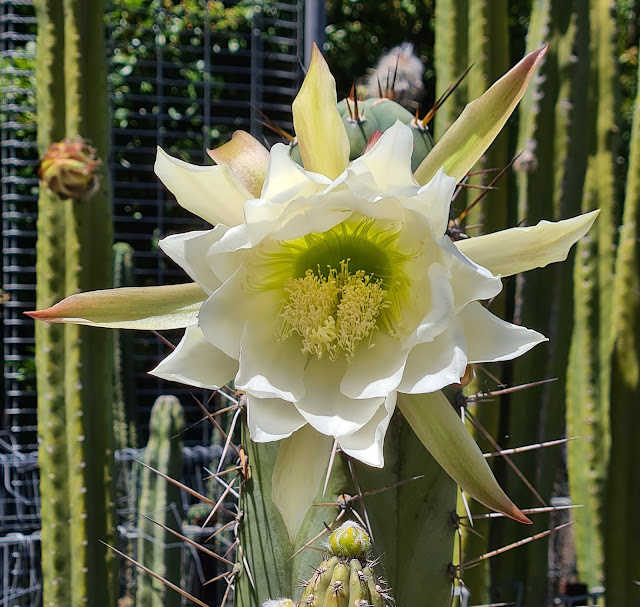Rose's cactus a good sport from northern Victoria
 |
| Echinopsis peruvianus 'Rosei 2' |
Apart from the distinctive blue-grey sheen, this cactus and its relatives have very showy, white, trumpet-like flowers. All the better to attract bat pollinators on the warm (even at high altitudes I presume) desert evenings.
 |
| Echinopsis peruvianus 'Rosei 2' |
In our Melbourne Gardens nursery collection of cacti that didn't make into the new arid garden, we have a few specimens labelled 'rosei 2', with rather long spines, and another tranche (photographed below) with very similar looking flowers but no obvious spines. The latter are labelled Echinopsis pachanoi.
Let's get the genus name out of the way. While some still accept Trichocereus as separate to a more broadly circumscribed Echinopsis, the molecular data support treating the two genera together as a single large genus, or splitting more aggressively into smaller genera. I'll follow here Royal Botanic Gardens Kew's Plant List, and call the two species I want to talk about today both Echinopsis.
In our residue from the collection of Robert Field (grown in Tennyson, near Echuca; inherited from his father Ralph Field; and originally sourced from the Americas during the 1938-39 Blossfeld expedition) plants of 'Rosei 2' and Echinopsis pachanoi were both in full bloom in mid-January.
 |
| Echinopsis peruvianus 'Rosei 2' |
Digging around online I see that 'Rosei 2', above, is most probably a selection from seed of Echinopsis peruvianus, from the town of Matucana in central Peru. That species has the common names Blue Torch or San Pedro Macho/Cactus.
Trichocereus rosei is an old name for the same species. Cereus rosei, as it was classified then, presumably honours the well-known American botanist and cactus expert, Joseph Nelson Rose. It was applied to the distinctive offspring of Echinopsis peruvianus by Ralph Field, who further separated two different variants as '1' and '2'. So our nursery cactus is best called Echinopsis peruvianus 'Rosei 2', treating it as a cultivar of that species. It has a lovely bluish hue and prominent spines.
Echinopsis peruvianus 'Rosei 1' is said to have shorter spines and an even more glaucous-blue surface. That too came from seed grown by the Field family and is now propagated as clones (from cuttings).
 |
| Echinopsis pachanoi |
Our similar looking species without obvious spines, Echinopsis pachanoi, is called the San Pedro Cactus (as are some other similar looking species, including Echinopsis peruvianus) and occurs naturally in places in the high Andes. It apparently can, but doesn't always (as in our specimens), produce spines.
 |
| Echinopsis pachanoi |
As a non-cactus expert, the flowers and the form of the cladode (the photosynthetic stem, supplying the plant with sugars in lieu of leaves, which are replaced by spines) in these two species look very alike. But I'm sure there are some fine details I'm missing, and equally sure my comrades in the Cactus and Succulent Society of Australia will set me straight, gently, if I have misconstrued the taxonomy.
I do know that both species and their close relatives share an interesting and similar chemistry, which I won't go into here.
 |
| Echinopsis pachanoi |
Comments
This is partially confirmed by doing a simple Google search on the name and you have to scroll down quite some distance before you get to anything close to an accepted cactus author. All preceding links are to parts of the modern-day Thrichocereus community and have no scientific support.
The differentiation between rosei 1 and rosei 2 is merely the difference between someone with freckles and someone without freckles, i.e. natural variation of a population.
A large percentage of the modern-day Thrichocereus community, as you note, has more than cacti on their mind.